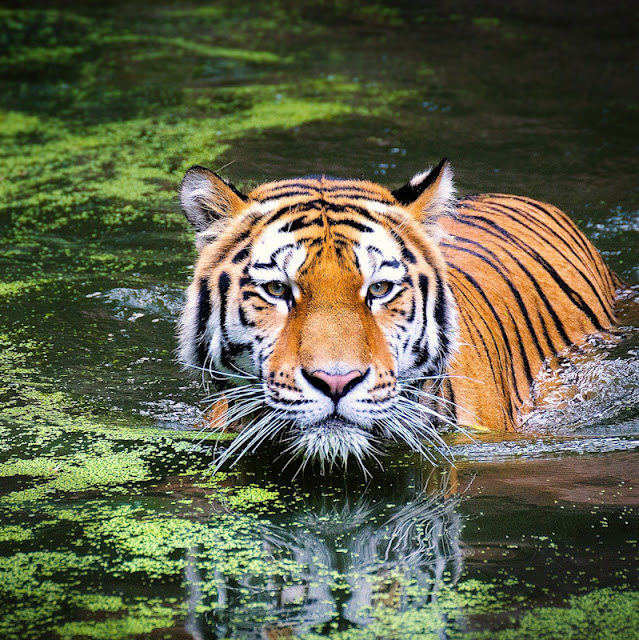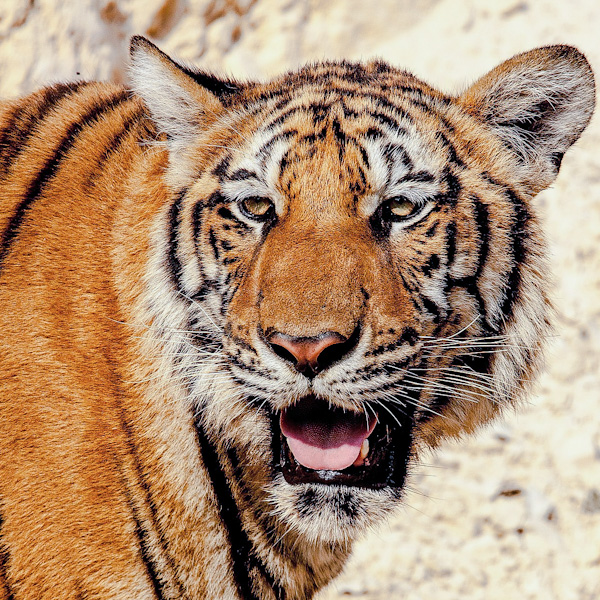Tiger Ecology, Behavior and Social Organisation
 |
| Bengal tigers like to spend the heat of the day in water to dissipate their body heat. Image in the public domain. |
| Tiger Attacked and Killed by Dogs. Image: Public domain. |
| Sambar deer. Image: public domain. |
The scope of the tiger's adaptability is evidenced in the width of the range. The Siberian tiger lives in an environment of coniferous and birch woods where there is snow and where temperatures can fall to the very low temperatures minus 30°C to minus 40°C. Snow can be a problem for a tiger both in terms of camouflage and stalking. Tigers avoid deep snow and icy snow can cut them. This is in contrast to the hot forests of Sumatra, where the Sumatran tiger lives (which shows how adaptable the tiger is). In Sumatra the tiger lives in ancient tropical lowland evergreen forest that is being cut down. It is also noisy making stalking difficult. Further south the Bengal tiger has adapted to living in swamps and sea water (Sunderbans, Bangladesh).
One predator that the tiger avoids is the human, which means it has become nocturnal. Given a free choice the tiger would hunt day or night and kill any animal that is vulnerable to it. Often hunting means traveling great distances by human standards. For example, males not uncommonly travel 30 kms per night in search of food. The search for food starts at sunset. Tiger have well-worn routines (don't domestic cats too) and will travel along the same routes to known hunting sites. A failure to catch prey means moving on as the tiger's presence is often by then well-advertised by the alarm calls of the deer.
Prey
As mentioned, tigers are adaptable and although there are favorite prey species, they will eat almost anything up to an elephant. But other top predators are not commonly attacked as prey for obvious reasons. Deer and wild pigs are the most common prey. The type of deer depends on the region. Typical deer species would be Sambar and Chittal (see photo). This preference for pigs and deer extends from India (Bengal tiger) to Russia (Siberian tiger - in Russia up 84% of all tiger kills are pigs or red deer7). In the south, say in Thailand the prey is smaller such as barking deer. The tiger does not select weak and/or old prey. Prey that is substantially larger than the tiger is also killed, e.g., water buffalo and gaur. In times past people, for entertainment, thrust buffalo and tiger together in a cage. The buffalo always won. So, this is dangerous prey. Tigers are killed by buffalo and bison. Bison can weigh between 500 and 1000 kgs (4-7 times a tiger's weight).
Tiger home ranges - social organization
The tiger is a wrestler rather than a runner. This dictates its hunting style. A tiger won't run far (150 metres) but prefers a short burst high impact attack. Small animals are killed by a bite to the back of the neck severing the vetebra while larger prey is suffocated by biting the throat. The former method is employed by the domestic cat. Whiskers and teeth feel the spot on the spine of the prey to severe it.
Prey is hauled to a safe spot under cover before feeding. The tiger's enormous strength comes into play here. There are some awesome stories. A tiger in Myanmar hauled a gaur weighing 770 kgs. Fourteen men couldn't move it7. Up to about 27 kgs of killed prey is eaten in a night7.
Social Organisation
Tigers like all cats are territorial. A dominant male's home range (the area that the tiger considers his area of operation) will overlap or encompass the usually exclusive (not overlapping) ranges of a number female tigers provided there is a sufficient density of females which is dependent on the prey base. While a less successful male tiger will be lucky to have one female. The male range is therefore much larger than that of the female tiger. Males will compete for a females particularly if the female density is low. Fights lead to injuries. Fights occur more frequently when there is social instability for any reason:
| Home Range | Sex | Location |
| 20 km² (average) | Female | India (Chitwan) |
| 40 - 300 km² | Male | India |
| 200 - 400 km² | Female | Siberia (Sikhote-Alin) |
| 800 - 1000 km² | Male | Sibera (Sikhote-Alin) |
| Vocalisation | Meaning/when |
| coughing snarl | before attack. |
| pooking | tell others of its presence. A kind of alarm call. |
| woof | when startled or surprised. Not made that often. |
| moan | made when walking along with head down. |
| prusten | friendly sound - greeting. |
| grunt | friendly sound. |
Tigers also communicate with their markings. For example, the white spot on the back of the ear flap (ocelli) gives a signal to opponents to beware as it becomes visible from the front when the ears are flattened (to protect them) prior to a fight. Most domestic cats flatten the ears in the same way but have lost the spots. Wild cat hybrid domestic cats retain them.
Reference:
7. Wild Cats of the World - Sunquists - 2002




Comments
Post a Comment
Please comment.